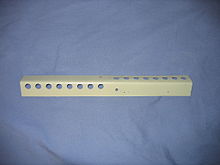Beekeeping/Mouse Guard

Mouse guards serve the purpose of restricting access to a beehive by pests such as mice and skunks. Some can simultaneously be used like a entrance reducer and control traffic, temperature and ventilation within a hive.
Usage
[edit | edit source]Most often, mouse guards are used prior to the onset and during the winter months to prevent mice from choosing a beehive as a hibernation spot. It is also not uncommon for mouse guards to be used year round in some locales to help in the control of pests. Mouse guards are often designed to be nailed or stapled across the entrance of a hive, between the bottom board and the lower hive body.
Selecting an Entrance Reducer
[edit | edit source]When selecting an entrance reducer, be sure that it is made of a material that a mouse or other pest cannot chew through. Mice will gleefully chew through wooden or thin plastic guards; thus, metal is often the best option. Some mouse guards are similar in design to small queen excluder; using one of these means that not only is the queen stuck inside the hive, but so are the drones. Dead and dying drone bodies can easily seal up the entrance and prevent worker bees from transiting to complete their necessary business.
Maintenance
[edit | edit source]- Entrance reducers may need to be occasionally scraped of propolis but should otherwise not need any real maintenance.
- Be sure to regularly clean dead bees from the entrance reducer and the opening to the beehive; this will help to prevent the hive from accidentally being sealed.
